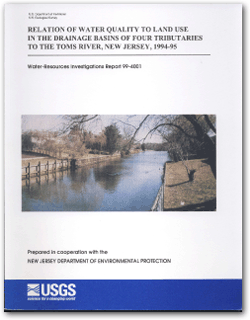Water-Resources Investigations Report 99–4001

AbstractThe influence of land use on the water quality of four tributaries to the Toms River, which drains nearly one-half of the Barnegat Bay wateshed, was studied during the initial phase of a multiyear investigation. Water samples were collected from and streamflows were measured in Long Swamp Creek, Wrangel Brook, Davenport Branch, and Jakes Creek during periods of base flow and stormflow in the growing and nongrowing seasons during May 1994 to October 1995. The drainage areas upstream from the seven measurement sites were characterized as highly developed, moderately developed, slightly developed, or undeveloped. Concentrations were determined and area-normalized instantaneous loads (yields) were estimated for total nitrogen, ammonia, nitrate, organic nitrogen, hydrolyzable phosphorus plus orthosphosphorus, orthophosphorus, total suspended solids, and fecal-coliform bacteria in the water samples. Specific conductance, pH, temperature, and dissolved oxygen were measured. Yields of total nitrogen, nitrate, and organic nitrogen at sites on Wrangel Brook, which drains moderately developed areas, were either larger than or similar to yields at the site on Long Swamp Creek, which drains a highly developed area. The magnitude of these yields probably was not related directly to the intensity of land development, but more likely was influenced by the type of development, the amount of base flow, and historical land use in the basin. The large concentrations of total nitrogen and nitrate in base flow in Wrangel Brook could have resulted from fertilizers that were applied to high-maintenance lawns and from agricultural runoff that has remained in the ground water since the 1950's and eventually was discharged to streams. Yields of ammonia appear to be partly related to the intensity of land development and storm runoff. Yields of ammonia at the site on Long Swamp Creek (a highly developed area) were either larger than or similar to yields at sites on Wrangel Brook (moderately developed areas). Yields were smallest at the site on Davenport Branch, which drains a slightly developed area. Yields of hydrolyzable phosphorus plus orthophosphorus and yields of orthophosphorus appear to be related to the intensity of development. Concentrations of hydrolyzable phosphorus plus orthophosphorus were greater in Long Swamp Creek (highly developed areas) than in Wrangel Brook (moderately developed areas). Concentrations of orthophosphorus were largest in Wrangel Brook (moderately developed) and Long Swamp Creek (highly developed). Total suspended solids and bacteria were somewhat related to intensity of development. Yields of total suspended solids were greater at sites downstream from highly and moderately developed areas than from slightly developed areas. Yields of bacteria were strongly related to streamflow and season. Specific conductance appears to be related to streamflow. pH probably was related to intensity of land development; pH was greater (more basic) in streams draining highly developed areas than in those draining other areas. Concentrations of dissolved oxygen were affected more by water temperature than by intensity of development or streamflow. |
For additional information contact: Part or all of this report is presented in Portable Document Format (PDF); the latest version of Adobe Reader or similar software is required to view it. Download the latest version of Adobe Reader, free of charge. |
Hunchak-Kariouk, Kathryn, 1999, Relation of water quality to land use in the drainage basins of four tributaries to the Toms River, New Jersey, 1994–95:
U.S. Geological Survey
Water-Resources Investigations Report 99-4001, 120 p.
Abstract
Introduction
Land Use in the Study Area
Methods of Study
Relation of Water Quality to Land Use
Summary
References Cited
Appendix 1: Estimated streamflow, and measured and calculated concentrations of water-quality constituents in samples collected at
measurement sites in the Toms River drainage basin, New Jersey, May 1994 to October 1995
Appendix 2: Area-normalized loads (yields) of selected water-quality constituents calculated for samples collected at measurement sites
in the Toms River drainage basin, New Jersey, May 1994 to October 1995